The Samsung 950 Pro PCIe SSD Review (256GB and 512GB)
by Billy Tallis on October 22, 2015 10:55 AM ESTSequential Write Performance
The sequential write test isn't limited to a small span of the disk, as that usually doesn't make a difference for this performance metric. As always, our averages are of the lower queue depths, but scaling to higher queue depths is also investigated. Bulk file copies and recording uncompressed video are the kind of uses that depend on sequential write performance.
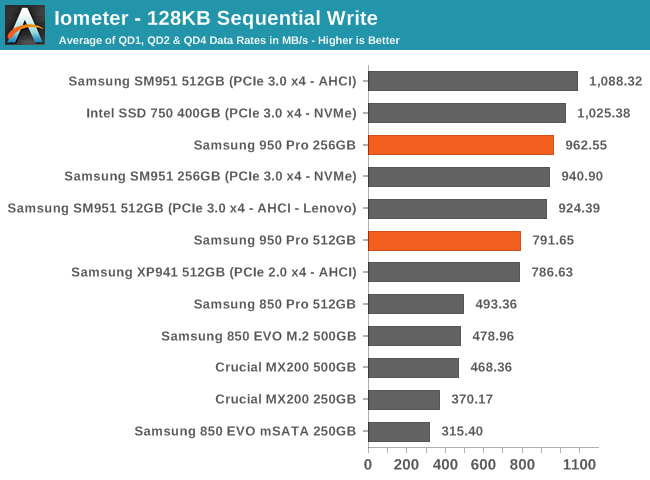
Even at low queue depths, most SSDs can spread a sequential write workload across multiple channels to achieve very high throughput. All of the PCIe drives perform well above the SATA limit but nowhere near the capacity of the PCIe links. The 512GB 950 Pro seems to again be encountering thermal throttling, and more severely than the SM951s we tested.
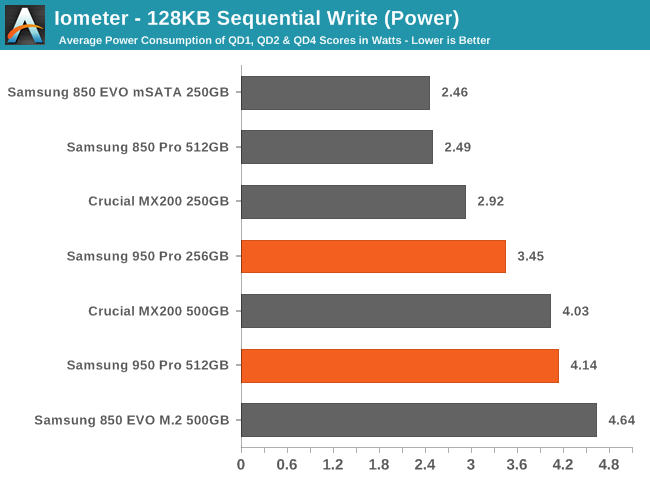
The average power consumption for writes is still on the high side by SATA standards, but is quite reasonable in light of the performance achieved.
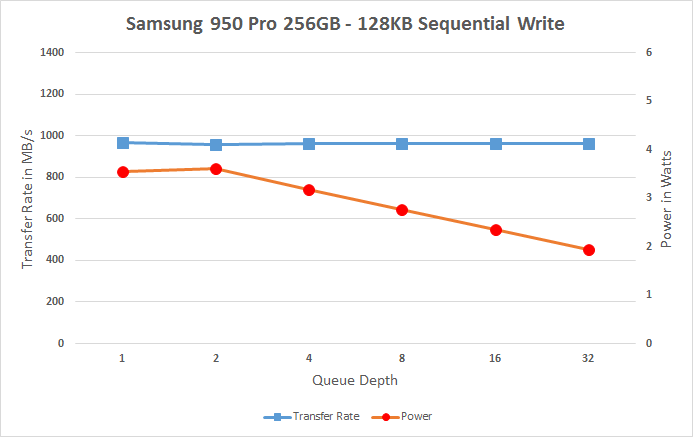 |
|||||||||
Performance across the sequential write test is mostly constant, but power isn't. The declines in power consumption in spite of increased queue depth are again most likely an artifact of whatever background processing is going on in the drive. On SATA drives, it's usually obvious from looking at the power meter when a drive has completed background processing and is truly idle and ready to run the next test, but with the lack of working power management for PCIe drives on our testbed I'm not so sure here. Overall it's probably a good sign that the drives were able to maintain high performance in spite of whatever else was going on, but given more cooling the 512GB can probably do much better.
Sequential Read Performance
Just like the random read test, sequential reads are tested across the span of a full drive and a representative sample of queue depths. Most operations involving large files (typically images and videos) fall under this test's purveiw, but streaming or playing even the highest resolution videos won't be a challenge for any of these drives. Copying files to another SSD or loading a new level in a video game would be more likely to show noticeable difference from better performance here.
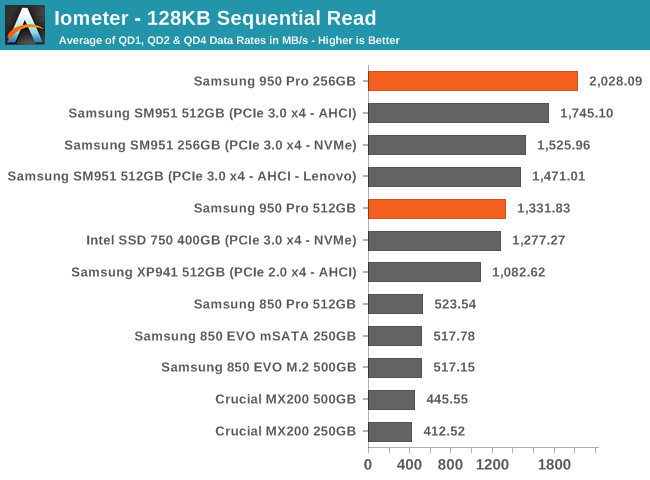
The sequential read performance is probably the best showcase of what the PCIe 3.0 x4 interface can do. The 256GB 950 Pro attains over half of the link speed, but the 512GB is again bogged down by something—relatively speaking, since it's still more than twice the speed of SATA and faster than even the Intel SSD 750. It's possible that the 950 Pro isn't faithfully implementing the secure form of the NVMe format command and some lingering fragmentation is preventing the 512GB drive from performing as specified. Read operations require less power to be supplied to the flash chip than for writes, but if the thermal throttling is all in the controller it could be showing up here as well.
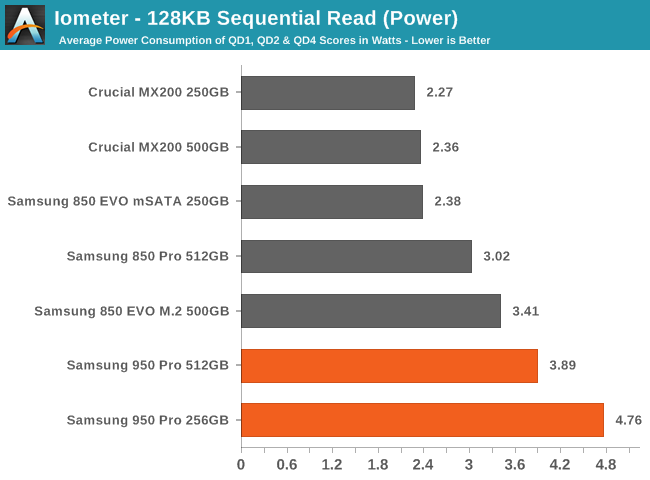
Relative to each other, the 950 Pro's power consumption is in line with the performance they're demonstrating, and proportionally much better than the SATA drives.
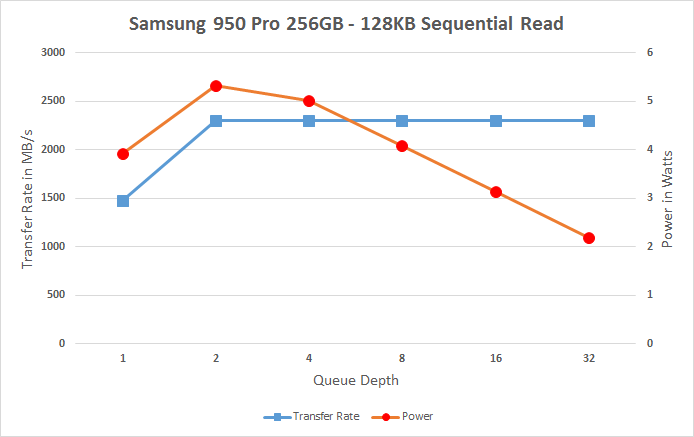 |
|||||||||
At queue depth 1, both of the 950 drives are performing similarly. When moving to higher queue depths the 256GB immediately hits 104% of its rated speed, but the 512GB doesn't improve any. (It's worth noting the differing scale for Transfer Rate in the graphs above.) The puzzling decline in power consumption at higher queue depths shows up again on the 256GB and definitely warrants deeper investigation.










142 Comments
View All Comments
Gigaplex - Thursday, October 22, 2015 - link
It's unlikely Samsung is holding back, as the phenomenon is affecting all brands.ddriver - Monday, October 26, 2015 - link
Corporations do price fixing, why not performance fixing.niva - Wednesday, October 28, 2015 - link
It is possible to do performance fixing, but not likely in this case. Enterprise hardware should generally concentrate on endurance, probably using different binning and better memory. I'm sure they can beef up the drivers too and optimize for certain loads. In general they'll get the most sales by selling in greater numbers. Artificially limiting performance so they can make more profit margin on some (much smaller quantities) hardware being sold to enterprise doesn't make sense.That all being said I guess it is possible.
ShieTar - Monday, October 26, 2015 - link
Yes, there is a DRAM cache. The size of it is listed in the table on the first page of the article.Without this, random writes would still be horrible, as overwriting a complete 128KB block whenever the drive is supposed to write down just 4KB leads quickly to the need of reading, deleting & re-writing the blocks, as no unused 128KB-blocks are left.
Laststop311 - Tuesday, October 27, 2015 - link
its just part of how nand cells works. If you need faster speed 3d xpoint is coming to save the day.Per Hansson - Wednesday, October 28, 2015 - link
The DRAM cache is not used to cache writes.It's large size is mainly for the NAND mapping table.
If writes where cached in DRAM the performance of 4KB random writes would of course be waaay higher than what it is.
And quite extreme dataloss would occur in case of power loss.
virtualbigd - Wednesday, December 16, 2015 - link
Can you elaborate on your reliability point above, for Samsung?virtualbigd - Wednesday, December 16, 2015 - link
I know about 840 EVO, is there something else?Samus - Thursday, October 22, 2015 - link
I have my reservations over Samsung drives, especially since the 840 EVO, but DAMN.jay401 - Saturday, October 24, 2015 - link
Hey if you turn that V upside down, you have the first A-NAND SSD. :D